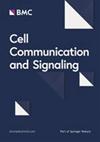TMEM100 是一种 TAK1 受体,可阻止病理性心肌肥厚的发展
IF 8.2
2区 生物学
Q1 CELL BIOLOGY
引用次数: 0
摘要
病理性心肌肥厚是心力衰竭的主要原因,但其潜在机制仍不完全清楚。跨膜蛋白 100(TMEM100)在神经系统疾病、疼痛和肿瘤发生等多种疾病中发挥作用,但其在病理性心肌肥厚中的功能仍不清楚。在这项研究中,我们观察到 TMEM100 在心肌肥厚中上调。功能研究表明,腺相关病毒9(AAV9)介导的TMEM100过表达小鼠可减轻横主动脉收缩(TAC)诱导的心脏肥大,包括心肌细胞增大、心脏纤维化以及心脏结构和功能受损。我们随后证实,腺病毒 TMEM100(AdTMEM100)可减轻苯肾上腺素(PE)诱导的体外心肌细胞肥大并下调心脏肥大标志物的表达,而 TMEM100 基因敲除则会加剧心肌细胞肥大。AdTMEM100组和对照组的RNA序列显示,TMEM100参与了PE刺激后的氧化应激和MAPK信号通路。从机理上讲,我们发现TMEM100的跨膜结构域(氨基酸53-75和85-107)直接与TAK1的C端区域(氨基酸1-300)相互作用,并抑制TAK1及其下游分子JNK和p38的磷酸化。与 TAK1 结合缺陷的 TMEM100 无法抑制 TAK1-JNK/p38 通路的激活。最后,应用 TAK1 抑制剂(iTAK1)发现,TAK1 是 TMEM100 介导的心脏肥大所必需的。总之,TMEM100 可通过 TAK1-JNK/p38 通路防止病理性心肌肥厚,可作为治疗心肌肥厚的一个有前途的靶点。本文章由计算机程序翻译,如有差异,请以英文原文为准。
TMEM100 acts as a TAK1 receptor that prevents pathological cardiac hypertrophy progression
Pathological cardiac hypertrophy is the primary cause of heart failure, yet its underlying mechanisms remain incompletely understood. Transmembrane protein 100 (TMEM100) plays a role in various disorders, such as nervous system disease, pain and tumorigenesis, but its function in pathological cardiac hypertrophy is still unknown. In this study, we observed that TMEM100 is upregulated in cardiac hypertrophy. Functional investigations have shown that adeno-associated virus 9 (AAV9) mediated-TMEM100 overexpression mice attenuates transverse aortic constriction (TAC)-induced cardiac hypertrophy, including cardiomyocyte enlargement, cardiac fibrosis, and impaired heart structure and function. We subsequently demonstrated that adenoviral TMEM100 (AdTMEM100) mitigates phenylephrine (PE)-induced cardiomyocyte hypertrophy and downregulates the expression of cardiac hypertrophic markers in vitro, whereas TMEM100 knockdown exacerbates cardiomyocyte hypertrophy. The RNA sequences of the AdTMEM100 group and control group revealed that TMEM100 was involved in oxidative stress and the MAPK signaling pathway after PE stimulation. Mechanistically, we revealed that the transmembrane domain of TMEM100 (amino acids 53–75 and 85–107) directly interacts with the C-terminal region of TAK1 (amino acids 1–300) and inhibits the phosphorylation of TAK1 and its downstream molecules JNK and p38. TAK1-binding-defective TMEM100 failed to inhibit the activation of the TAK1-JNK/p38 pathway. Finally, the application of a TAK1 inhibitor (iTAK1) revealed that TAK1 is necessary for TMEM100-mediated cardiac hypertrophy. In summary, TMEM100 protects against pathological cardiac hypertrophy through the TAK1-JNK/p38 pathway and may serve as a promising target for the treatment of cardiac hypertrophy.
求助全文
通过发布文献求助,成功后即可免费获取论文全文。
去求助
来源期刊

Cell Communication and Signaling
CELL BIOLOGY-
CiteScore
11.00
自引率
0.00%
发文量
180
期刊介绍:
Cell Communication and Signaling (CCS) is a peer-reviewed, open-access scientific journal that focuses on cellular signaling pathways in both normal and pathological conditions. It publishes original research, reviews, and commentaries, welcoming studies that utilize molecular, morphological, biochemical, structural, and cell biology approaches. CCS also encourages interdisciplinary work and innovative models, including in silico, in vitro, and in vivo approaches, to facilitate investigations of cell signaling pathways, networks, and behavior.
Starting from January 2019, CCS is proud to announce its affiliation with the International Cell Death Society. The journal now encourages submissions covering all aspects of cell death, including apoptotic and non-apoptotic mechanisms, cell death in model systems, autophagy, clearance of dying cells, and the immunological and pathological consequences of dying cells in the tissue microenvironment.
 求助内容:
求助内容: 应助结果提醒方式:
应助结果提醒方式:


